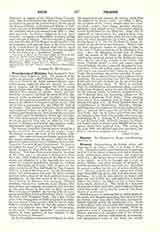

Pious Society of Missions, the, founded by Ven. Vincent Mary Pallotti in 1835. The members of the society are generally called Pallottini Fathers. Its object is to preserve the Faith among Catholics, especially among emigrants, who are exposed to many grave dangers, and to propagate the Faith among non-Catholics and infidels. The Society of Missions embraces three classes: (I) priests, clerics, and lay-brothers; (2) sisters, who help the priests in their missionary works as teachers and catechists, and who care for the temporal necessities of their churches and houses; (3) affiliated ecclesiastics and lay people. The sisters live a community life, and follow the Rule of St. Francis. They dedicate themselves to the spiritual and temporal welfare of their sex. They are especially engaged in missionary work among the emigrants in America, and the infidels in Africa and Australia. The third class consists of both the secular and regular clergy and the laity who are affiliated with the Society of Missions and help by their prayers, works, and financial aid the propagation of the Faith.
The founder prescribed that his society should be a medium between the secular and the regular clergy. He desired to foster the work of the Catholic Apostolate. This desire of his was strikingly symbolized by the annual celebration of the octave (which he inaugurated in 1836) and the feast of Epiphany in Rome (see Pallotti, Vincent Mary, Venerable). He gave to his society the name of “Catholic Apostolate”, afterwards changed by Pius IX to the “Pious Society of Missions“. The word Pious is to be taken in the sense of the Latin pia, i. e., devoted or dedicated to God. On January 9, 1835, Pallotti conceived the plan of his institute and submitted it to the Apostolic See, and received the required approbation through the cardinal vicar, Odescalchi, on April 4, 1835, as again by another rescript on May 29, and finally by Pope Gregory XVI on July 14 of the same year. Nearly all religious orders and communities favored the newly-created institute with a share in all their spiritual works and indulgences. In the first years of its existence the Pious Society of Missions had among its affiliated members, twenty-five cardinals, many bishops, Roman princes, and religious communities and societies, as also men known in that time as great apostles, Blessed Caspar del Buffalo, the founder of the Congregation of the Most Precious Blood and Maria Clausi of the Order of St. Francis of Paula. For a time the Society of the Propagation of Faith in Lyons feared that the new society would interfere with its special work. Pallotti satisfied the Holy See that the purpose of his society was different from that of the Propagation. As the name, “Catholic Apostolate”, occasioned objections in some quarters, it was changed to the “Pious Society of Missions“.
At the Camaldolese convent near Frascati, he wrotethe constitution and rules for the society, which Pius IX approved ad ternpus, 1846. According to them, the members of the society should, after two years’ novitiate, promise four things, poverty, chastity, obedience, and refusal of any ecclesiastical dignity, except by obedience to the Holy See. Pope Pius X approved ad experiendum the newly-revised rules and constitutions, December, 1903, for six years, and gave the final approbation on November 5, 1909. The mother-house is in the Via Pettinari 57, Rome, attached to the church of San Salvatore. Pallotti sent his first missionary fathers to London in 1844, to take care of Italian emigrants in the Sardinian Oratory. Rev. D. Marquese Joseph Fah. di Bruno built the church of St. Peter in Hatton Garden which is the principal church of the Italians in London. He was one of the generals of the society, and wrote “Catholic Belief“, a clear and concise exposition of Catholic doctrine, especially intended for non-Catholics. Over one million copies of this book were sold, and it was translated into Italian by the author. Under his generalate, the society extended its activity beyond Rome, Rocca Priora, and London to other countries. He received from Leo XIII the church of S. Silvestre in Capite in Rome for the use of the English-speaking colony there. In Masio in northern Italy, he established an international college, a mission at Hastings, England, and in London (St. Boniface’s) for the German colony; in Limburg, Ehrenbreitstein, and Vallemdar there are flourishing colleges for the missions in Kamerun, West Africa. These missions have now a vicar Apostolic and 12 houses, with 70 schools belonging to it. In South America there are establishments at Montevideo, Mercedes, Saladas, and Suipacha; 14 missions of the society in Brazil embrace a territory three times the size of the State of New York. Rev. Dr. E. Kirner started the first Italian Mission in New York City in 1883, afterwards one in Brooklyn, N. Y., Newark, N. J., Hammondton, N. J., and Baltimore, Md. In North America the Pallottini Fathers have at present over 100,000 Italian emigrants under their spiritual care. The society, in the year 1909, was divided into four provinces, the Italian, American, English, and German.
JOHN VOGEL

